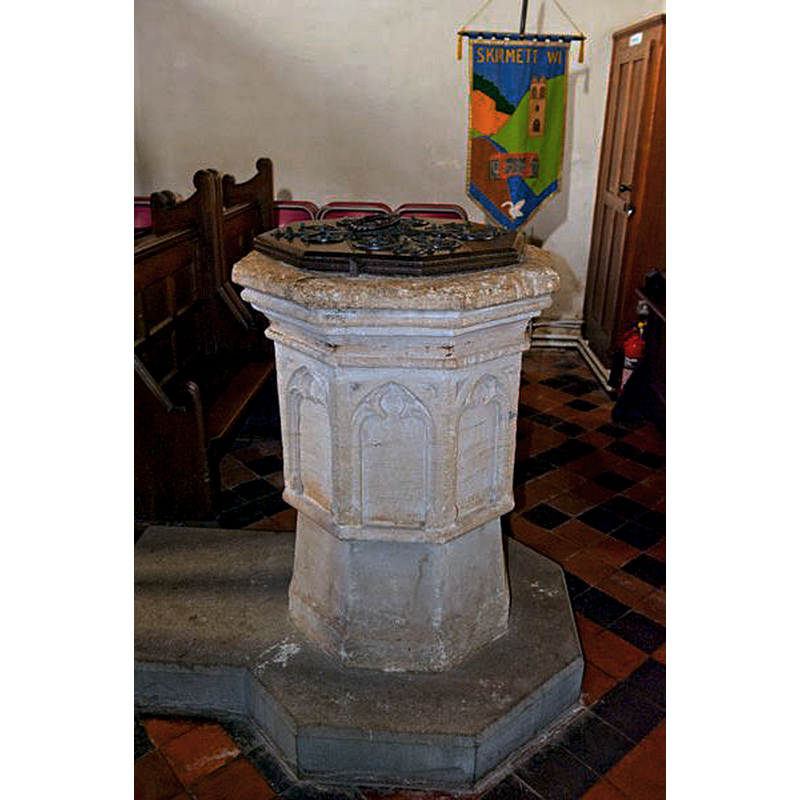Fingest / Fimghurst / Fingherst / Finghurst / Fyngerst / Thingest / Thinghurst / Tingbearst / Tingerst / Tinghurst / Tyngehurst / Tynghurst / Tynhurst / Vingest

Image copyright © Stefan Czapski, 2013
CC-BY-SA-2.0
Results: 5 records
design element - architectural - arcade - blind - trefoiled arches or windows - 8
design element - motifs - moulding - graded
view of church exterior - east view
Scene Description: Source caption: "Fingest church from the east. Much of the church is of Norman origin, in particular the west tower, which Pevsner reckons is 27 feet square at its base - wider than the nave. Nonetheless, the tower's most distinctive feature - its double pitched roof with brick-built gables - is without doubt a much later addition. Pevsner guessed it might date from the 17th century (see the Buckinghamshire volume of 'The Buildings of England') while the Listing Text (compiled in 1955) suggests an 18th or early 19th century date."
Copyright Statement: Image copyright © David Ross & Britain Express Ltd, 2015
Image Source: digital photograph taken by David Ross [www.britainexpress.com/images/attractions/editor/Fingest-8478.jpg] [accessed 8 October 2015]
Copyright Instructions: Standing permission
view of church exterior - southeast view
INFORMATION
FontID: 10588FIN
Object Type: Baptismal Font1
Church/Chapel: Parish Church of St. Bartholomew
Church Patron Saints: St. Bartholomew
Church Location: Fingest, Henley-on-Thames, Oxfordshire, RG9 6QE
Country Name: England
Location: Buckinghamshire, South East
Directions to Site: Located 10 km NNE of Henley-on-Thames 10 WSW of High Wycombe, 12-13 km NW of Marlow
Ecclesiastic Region: Diocese of Oxford
Historical Region: Hundred of Desborough
Font Location in Church: Inside the church, at the W end, beneath the tower
Century and Period: 15th century [basin only] [composite font], Late Medieval
Credit and Acknowledgements: We are grateful to David Ross, Britain Express Ltd [www.britainexpress.com], for his photograph of this font
Church Notes: original church probably late-Norman as is the west tower, but the saddle-back top is actually modern, 18th or 19thC?
Font Notes:
Click to view
No entry found for Fingest in the Domesday syrvey. Lysons (1806-1833) describe an octagonal baptismal font "enriched with arches", but Lewis' Dictionary of 1848 reports the font, as "circular, and enriched with arches". Sheahan (1862) reports: "The font is octangular". Described in the RCAHM (Buckinghamshire, 1912): "octagonal bowl, with moulded rim, and a trefoiled sunk panel in each side, 15th-century, base and stem, modern." The Victoria County History (Buckingham, vol. 3, 1925) notes that the identification of the entry for 'Dileherst' [Domesday, 1086] as Fingest, which Lipscomb (1831-1843) and other earlier writers suggest, is wrong; the present-day corresponding place is 'Tylers Green', in Burnham Hundred [NB: Fingest was in Desborough Hundred]. The VCH (ibid.) further notes that there is no entry for Fingest Manor in the Domesday Book. The VCH (ibid.) notes the 12th-century tower and nave, and adds: "The panelled octagonal bowl of the font is of the 15th century, but the stem and base are modern." Noted in Pevsner (1960): "Font. Simple, octagonal, C14." On-site notes: two volumes: the basin has graded mouldings around the upper side below which is a blank arcade of pointed arches with trefoiled windows; at the bottom rim of the basin a single thin roll moulding; the pedestal base is broad, octagonal and plain; it is raised on an octagonal plinth with kneeling stone. The basin is lead lined; central drain. [NB: despite the contradictory shape given by Lewis (round) [cf. supra], the Hambleden Valley Churches web site confirms the octagonal shape of this 15th-century font].
COORDINATES
Church Latitude & Longitude Decimal: 51.613742, -0.879804
Church Latitude & Longitude DMS: 51° 36′ 49.47″ N, 0° 52′ 47.29″ W
UTM: 30U 646794 5720208
MEDIUM AND MEASUREMENTS
Material: stone
Font Shape: octagonal (mounted)
Basin Interior Shape: round
Basin Exterior Shape: octagonal
Drainage Notes: lead lining
LID INFORMATION
Date: modern?
Material: wood, oak
Apparatus: no
Notes: octagonal and flat, with metal decoration and ring handle; appears modern; perhaps 19th-century?
REFERENCES
Victoria County History [online], University of London, 1993-. Accessed: 2011-05-27 00:00:00. URL: https://www.british-history.ac.uk.
Great Britain. Royal Commission on Historical Monuments (England), An inventory of the historical monuments in Buckinghamshire, London: H.M. Stationary Office, 1912-
Lewis, Samuel, A Topographical Dictionary of England, Comprising the Several Counties, Cities, Boroughs, Corporate and Market Towns, Parishes, Chapelries, and Townships, and the Islands of Guernsy, Jersey, and Man, with Historical and Statistical Descriptions [...], London: S. Lewis, 1831
Lysons, Daniel, Magna Britannia, being a concise topographical account of the several counties of Great Britain, London: Printed for T. Cadell and W. Davies, 1806-1822
Pevsner, Nikolaus, Buckinghamshire, Harmondsworth: Penguin, 1960
Sheahan, James Joseph, History and topography of Buckinghamshire, comprising a general survey of the county, preceded by an epitome of the early history of Great Britain, London; Pontefract: Longman, Green, Longman, and Roberts; William Edward Bonas [...], 1862

